According to archaeologists, construction of the Ajanta caves in Maharashtra, India, began about 2200 years ago. Over hundreds of years of work, more than 30 monuments were laboriously cut into the rock face of the mountains. According to speculation, the use of the caves stopped around 1000 AD for unknown reasons, letting a thick jungle canopy grown around them, hiding them away for many generations.
|
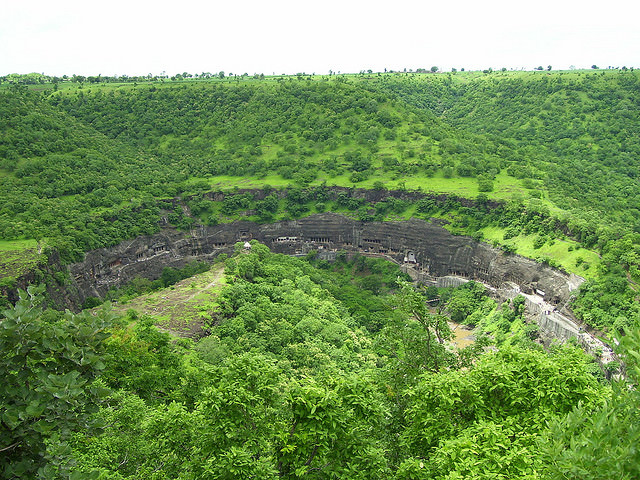 |
No human eye saw the caves again until centuries later, when, in 1819, an Englishman by the name of John Smith was hunting a tiger when he discovered a hidden doorway to one of the temples. We know this because he unfortunately left his name on the wall of the temple - and a date, which can still be seen today.
|
 |
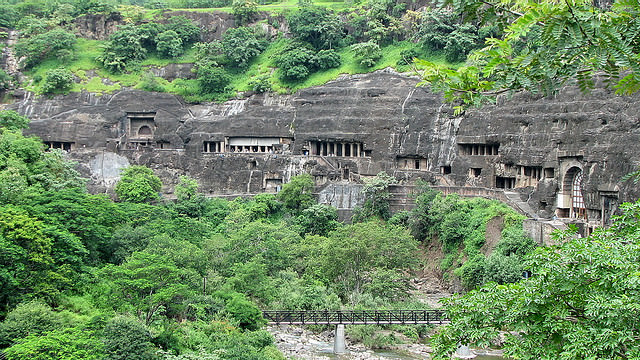 |
But although that first English discoverer did not go immediately public with his discovery, the existence of the caves became known, and soon after Indian and European tourists started pouring into the ancient site - after much digging and cleaning, that is (the caves were home to many species of animals for centuries).
|
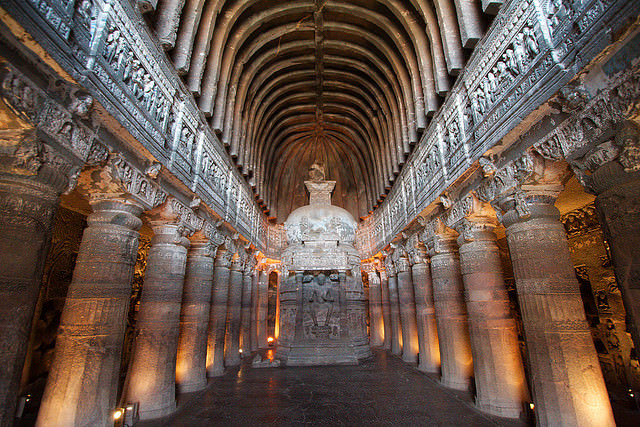 |
 |
Experts have dated the caves from the second century BC - 200 years before the birth of Christ. Their function seems to be ritualistic, used as prayer halls. Much use of Roman design is evident in the columns and arches of the caves. The hard rock face of the caves was apparently chiseled with rough tools and even bare hands.
|
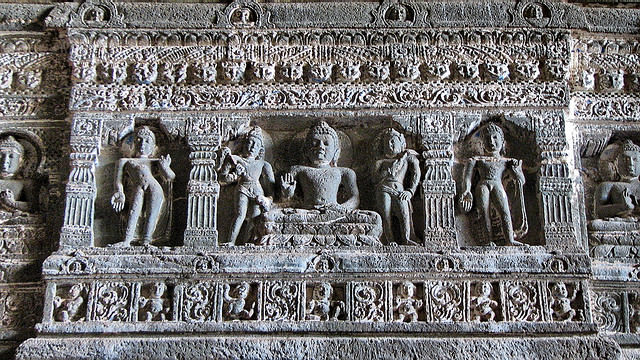 |
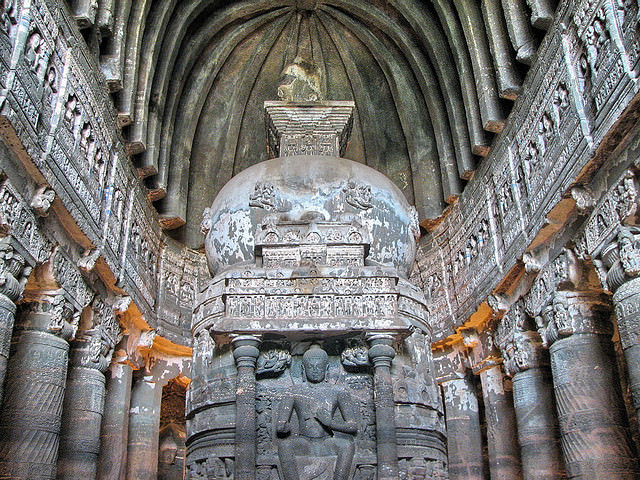 |
It seems that the first hallowed caves were dug during the time of The Sātavāhana Empire, which dates back to about 230 BC.
|
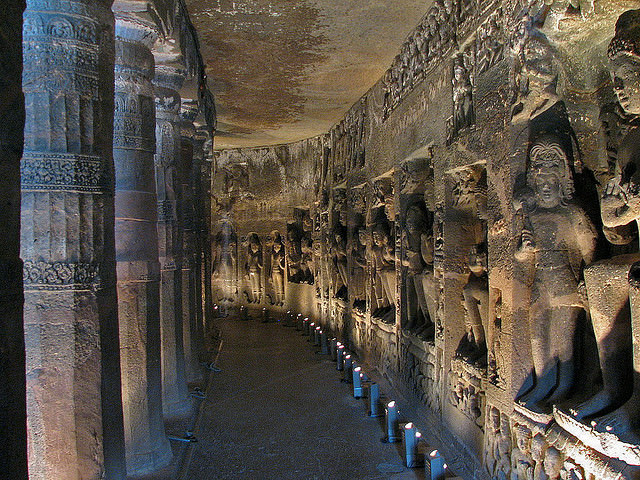 |
Almost every surface but the floor is covered in paintings - literally. They have lost much of their former glory, of course, but efforts are being made to restore them. Poems are also painted on the walls - 547 of them - which tell stories of Buddha's previous lives.
|
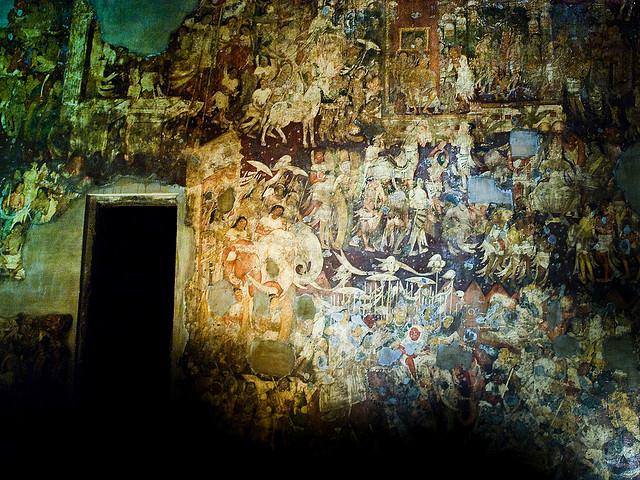 |
To create them, a chisel was used to make room for plaster on the walls which was spread on teh surface. Before it dried, the painter would paint on it, soaking it into the plaster so it became part of the surface. This method has been proven to survive over 2000 years.
|
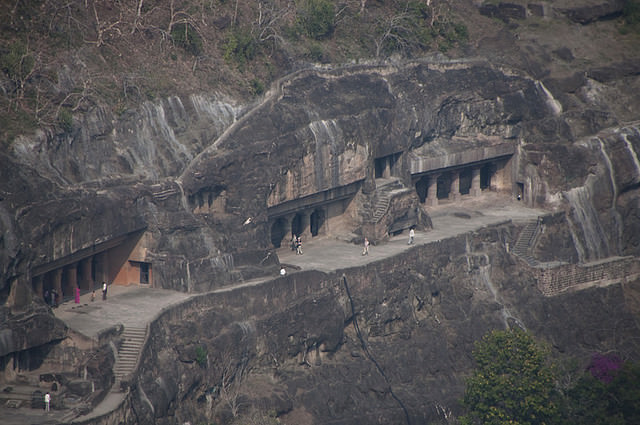 |
No one knows why the caves were deserted, and we may never know the answer to this mystery. But they continue to draw many visitors who marvel at the art of the ancients that came before them.
|
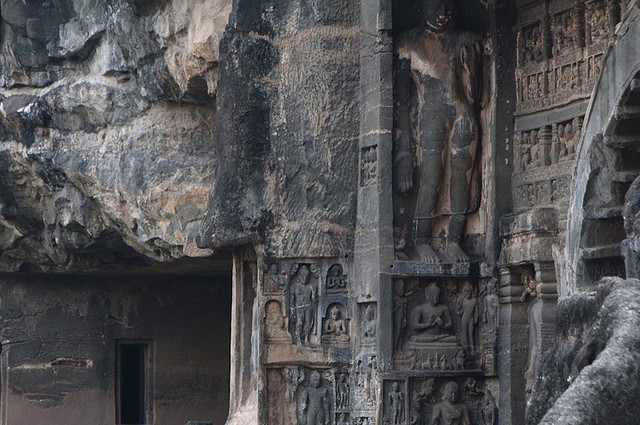 |
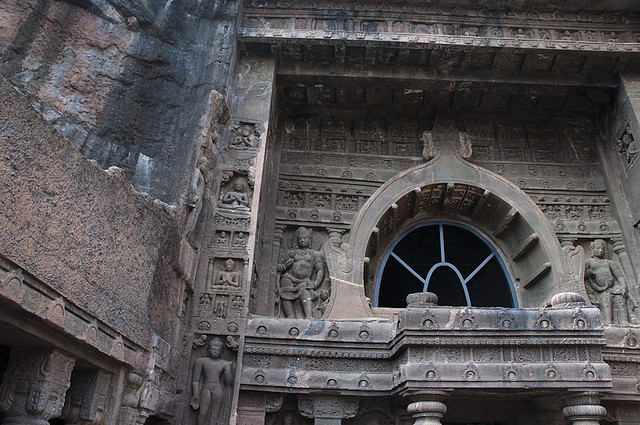 |
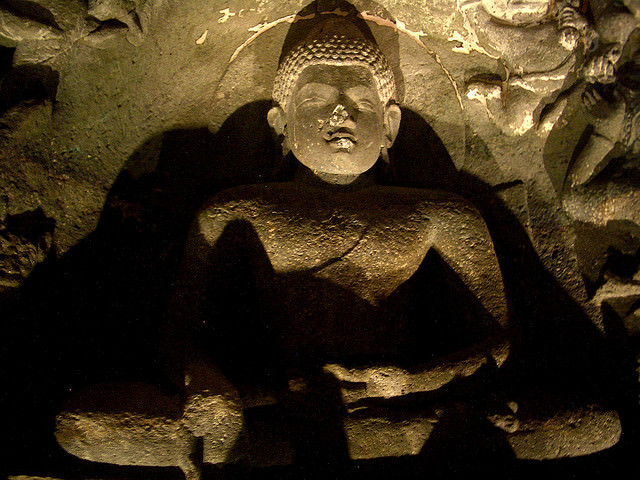 |
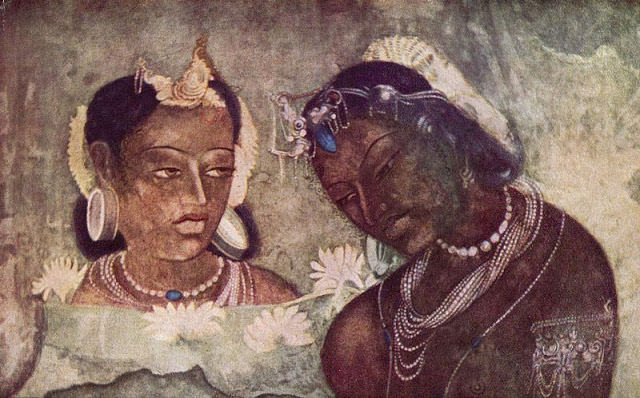 |
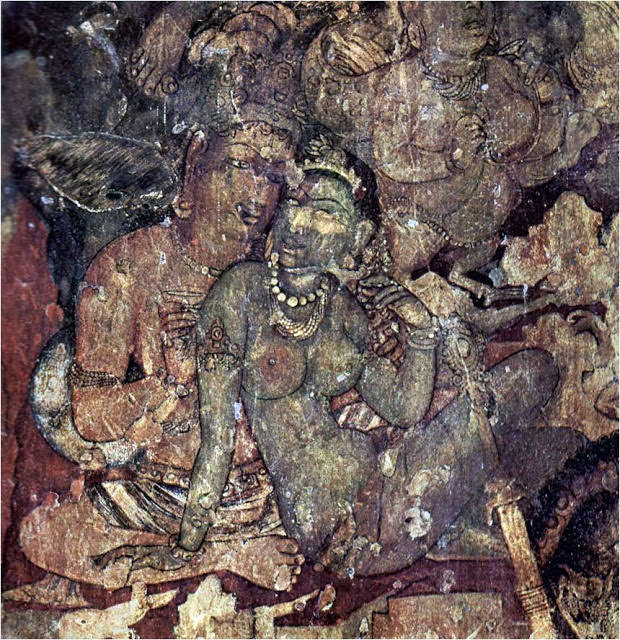 |
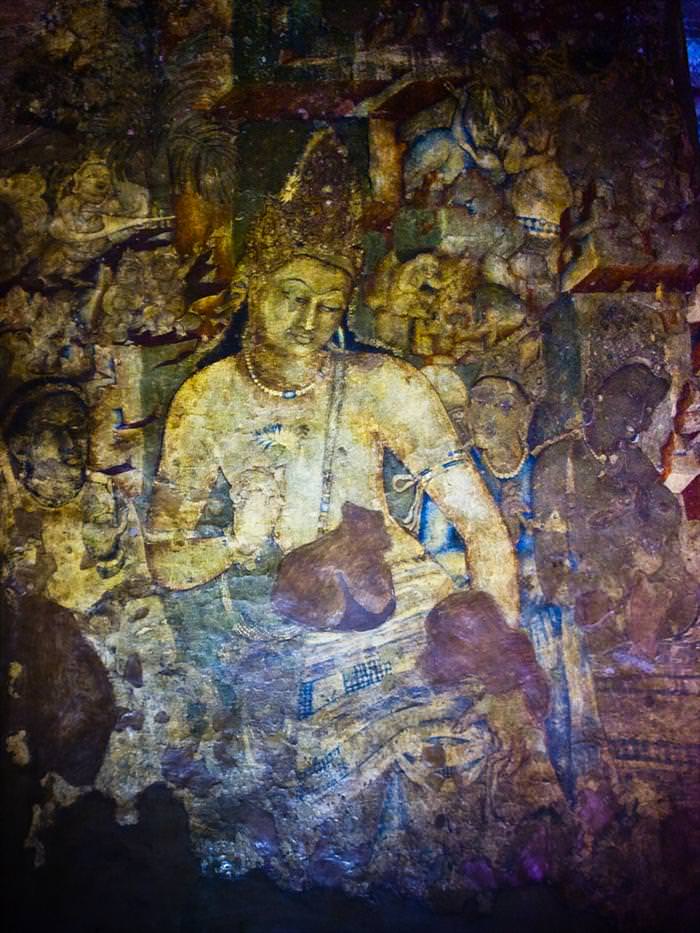 |
 |
 |
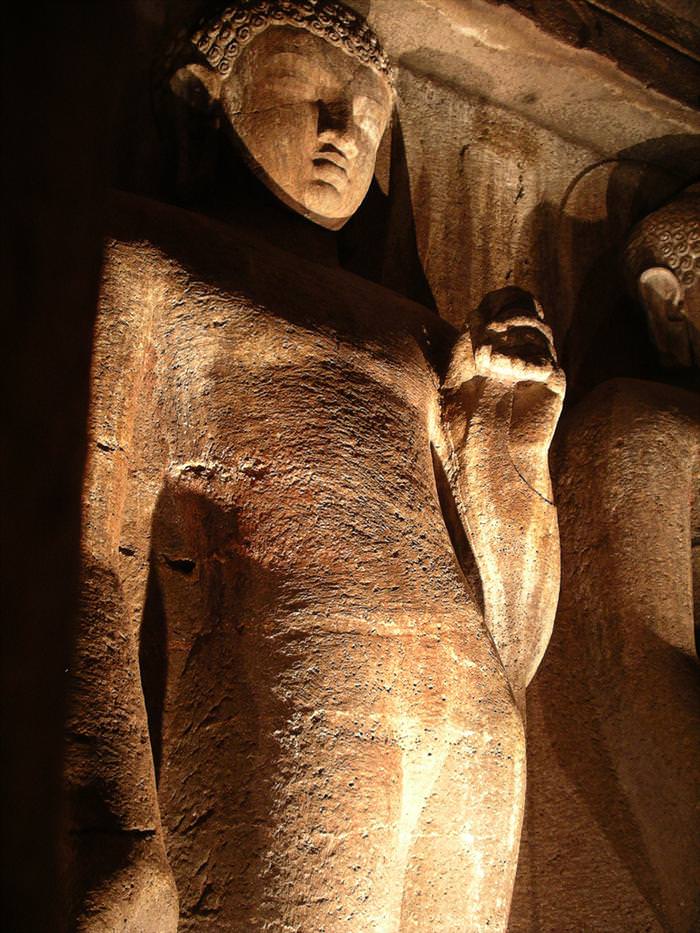 |
 |
Saturday 28 June 2014
The Mysterious Ajanta Caves!
Wednesday 25 June 2014
An Orgy of Violence Thru Jihads (some sane Muslim voice)
An Orgy of Violence Thru Jihads (some sane Muslim voice)
Face of Islam--Tarek Fatah and MJ Akbar are always worth reading, watching on TV. The Two sane muslim voices:MJA had stated that since 1947 more muslims have been killed in Pakistan by other muslims.By Tarek Fatah, Toronto Sun
 Personnel from the Kurdish security forces detain a man suspected of being a militant belonging to the al Qaeda-linked Islamic State in Iraq and the Levant (ISIL) in the outskirts of Kirkuk June 16, 2014. (Reuters)The world is ablaze in an orgy of jihadi terror and war in the lands of Islam and no one seems to know what to make of it, let alone how to resolve the crisis.The brutality of this mayhem was best captured in a deeply disturbing video released on the Internet by jihadis fighting for the “Islamic State of Iraq and Syria” (ISIS).It shows a bearded, young ISIS fighter in full battle gear posing for the camera with a decapitated head in his hand.On cue from the cameraman, the jihadi fighter lifts the head, turns towards it and says, “Hello, my name is John.”Both men then break into laughter, after which the cameraman derisively remarks, “Why doesn’t John look like he died of natural causes?”The decapitated head is then thrown to the ground as another ISIS man can be heard off camera joking: “This guy died of natural causes by a knife ... It cut his throat”, to which the cameraman guffaws, “Natural causes — the mujahedeen ... Natural cause for an apostate,” before chanting the Islamic battle cry, “Allah O Akbar.”This desecration of a dead body is not an isolated incident.Just last year the Taliban were filmed playing football with the decapitated heads of beheaded prisoners — fellow Muslims.And while much of the Islamic community is in a state of denial, blinded to the atrocities being committed by their co-religionists across the globe, the rest of the world watches in shock.In Kenya and Nigeria Islamists are targeting Christians while in Iraq and Pakistan they are killing Shia Muslims, who Saudi-funded clerics have designated as “Kafirs”, non-believers in Islamic disguise whose founders, they falsely claim, were Jews.The apologists among us claim these atrocities are not part of the Islamic rules of war, but that does not withstand scrutiny.The fact is, no less a person than the grandson of Prophet Muhammad was beheaded in battle by fellow Muslims on Oct. 10, 680. His decapitated head was paraded in the streets of Damascus.The eminent Egyptian Islamic reformer of the 20th century, Ali Abd al-Razik, writes in his book Islam and the Fundamentals of Authority that within a year of Prophet Muhammad’s death, political disputes among the Muslims were settled by public beheadings.Raziq writes about one incident of early Islam when the celebrated Muslim general Khalid Ibn Walid made a cooking pot out of the decapitated head of another Muslim general, Malik ibn Nuwairah, after defeating him in a battle and beheading him as a POW.Fortunately, Canada is the only western country that has a critical mass of liberal Muslims honest enough to acknowledge the fact that not all of our history is as unblemished as our parents and clerics wanted us to believe as children.The slaughters we read about in Syria, Kenya, Iraq, Pakistan, Nigeria and Afghanistan have common factors.They’re the same ones that feature in the so-called honour killings and female genital mutilation of girls in the UK, Canada, America and Europe, as well as in much of the Arab world and Africa.Those factors are Islamism and sharia.The sooner we Muslims acknowledge this truth, the better equipped we will be to join the rest of humanity as partners in peace for our common good.If not, we may well end up in the scrap heap of history.
Personnel from the Kurdish security forces detain a man suspected of being a militant belonging to the al Qaeda-linked Islamic State in Iraq and the Levant (ISIL) in the outskirts of Kirkuk June 16, 2014. (Reuters)The world is ablaze in an orgy of jihadi terror and war in the lands of Islam and no one seems to know what to make of it, let alone how to resolve the crisis.The brutality of this mayhem was best captured in a deeply disturbing video released on the Internet by jihadis fighting for the “Islamic State of Iraq and Syria” (ISIS).It shows a bearded, young ISIS fighter in full battle gear posing for the camera with a decapitated head in his hand.On cue from the cameraman, the jihadi fighter lifts the head, turns towards it and says, “Hello, my name is John.”Both men then break into laughter, after which the cameraman derisively remarks, “Why doesn’t John look like he died of natural causes?”The decapitated head is then thrown to the ground as another ISIS man can be heard off camera joking: “This guy died of natural causes by a knife ... It cut his throat”, to which the cameraman guffaws, “Natural causes — the mujahedeen ... Natural cause for an apostate,” before chanting the Islamic battle cry, “Allah O Akbar.”This desecration of a dead body is not an isolated incident.Just last year the Taliban were filmed playing football with the decapitated heads of beheaded prisoners — fellow Muslims.And while much of the Islamic community is in a state of denial, blinded to the atrocities being committed by their co-religionists across the globe, the rest of the world watches in shock.In Kenya and Nigeria Islamists are targeting Christians while in Iraq and Pakistan they are killing Shia Muslims, who Saudi-funded clerics have designated as “Kafirs”, non-believers in Islamic disguise whose founders, they falsely claim, were Jews.The apologists among us claim these atrocities are not part of the Islamic rules of war, but that does not withstand scrutiny.The fact is, no less a person than the grandson of Prophet Muhammad was beheaded in battle by fellow Muslims on Oct. 10, 680. His decapitated head was paraded in the streets of Damascus.The eminent Egyptian Islamic reformer of the 20th century, Ali Abd al-Razik, writes in his book Islam and the Fundamentals of Authority that within a year of Prophet Muhammad’s death, political disputes among the Muslims were settled by public beheadings.Raziq writes about one incident of early Islam when the celebrated Muslim general Khalid Ibn Walid made a cooking pot out of the decapitated head of another Muslim general, Malik ibn Nuwairah, after defeating him in a battle and beheading him as a POW.Fortunately, Canada is the only western country that has a critical mass of liberal Muslims honest enough to acknowledge the fact that not all of our history is as unblemished as our parents and clerics wanted us to believe as children.The slaughters we read about in Syria, Kenya, Iraq, Pakistan, Nigeria and Afghanistan have common factors.They’re the same ones that feature in the so-called honour killings and female genital mutilation of girls in the UK, Canada, America and Europe, as well as in much of the Arab world and Africa.Those factors are Islamism and sharia.The sooner we Muslims acknowledge this truth, the better equipped we will be to join the rest of humanity as partners in peace for our common good.If not, we may well end up in the scrap heap of history.
Tuesday 24 June 2014
No freebies for families of bureaucrats, public sector employees etc...
| MITUL THAKKAR RAJEEV JAYASWAL |
Two weeks into the tenure of the Narendra Modi-led government, executives of state run blue-chip firms are already feeling a perceptible change at the Centre. The offices of power minister Piyush Goyal, petroleum minister Dharmendra Pradhan and steel minister Narendra Singh Tomar have not sought freebies such as air tickets, guest houses, personal staff or vehicles for their families or staff members. This is a decisive departure from the past, executives told ET, admitting that the first task of chairmen of public sector giants after the installation of a new central government often used to be to ensure a fleet of swanky sedans and household helps, among other facilities, to make life easier for the staff of the ministers.
The central ministers have always had at their beck and call chief executives seeking quick approvals for juicy contracts, foreign junkets and extension to their tenures; directors aspiring to head blue-chip companies and senior executives whose job is to liaise with these privileged people -the bunch that surrounds powerful Cabinet ministers and deftly makes political masters inaccessible to the world.
But executives of firms such as NTPC, ONGC, SAIL, BHEL, IOC and Gail say the new government seems different.
“It sounds unusual. Not only minister and their personal staff, we had to oblige their close friends and associates right from the swearing-in ceremony. I think this is the Modi effect. It seems everyone is emulating him,“ said a former chairman of a maharatna oil firm, requesting anonymity.
Things are different at Goyal's office, says a serving chairman of a company . “Despite several requests, we could not easily get time to meet and greet him,“ said the chairman, who did not wish to be identified. For many public sector bigwigs, this change could make life tougher. With companies making profits of thousands of crores of rupees, a few air tickets, paid holidays in luxury resorts and white goods were a small price to pay to get the top authorities to look aside when there was some bungling in business. But this time, the ministers demand performance, not indulgence, senior government officials and executives said.
“Top ONGC executives faced a difficult situation while demanding some exemption from paying fuel subsidy at a meeting with the oil minister. The minister questioned their performance as they bid and bagged about 50% of blocks the government auctioned under new exploration licensing policy , but not even one was producing,“ a person present at the meeting said.
ONGC chairman DK Sarraf declined to comment on the matter.
Pradhan had earlier told ET that his entire focus would be on enhancing oil and gas output and that he had directed state-run oil companies to improve management efficiency on priority. Goyal has been even more blunt in his approach as he did not give appointments to many top executives of power and coal PSUs to offer bouquets.
Two weeks into the tenure of the Narendra Modi-led government, executives of state run blue-chip firms are already feeling a perceptible change at the Centre. The offices of power minister Piyush Goyal, petroleum minister Dharmendra Pradhan and steel minister Narendra Singh Tomar have not sought freebies such as air tickets, guest houses, personal staff or vehicles for their families or staff members. This is a decisive departure from the past, executives told ET, admitting that the first task of chairmen of public sector giants after the installation of a new central government often used to be to ensure a fleet of swanky sedans and household helps, among other facilities, to make life easier for the staff of the ministers.
The central ministers have always had at their beck and call chief executives seeking quick approvals for juicy contracts, foreign junkets and extension to their tenures; directors aspiring to head blue-chip companies and senior executives whose job is to liaise with these privileged people -the bunch that surrounds powerful Cabinet ministers and deftly makes political masters inaccessible to the world.
But executives of firms such as NTPC, ONGC, SAIL, BHEL, IOC and Gail say the new government seems different.
“It sounds unusual. Not only minister and their personal staff, we had to oblige their close friends and associates right from the swearing-in ceremony. I think this is the Modi effect. It seems everyone is emulating him,“ said a former chairman of a maharatna oil firm, requesting anonymity.
Things are different at Goyal's office, says a serving chairman of a company . “Despite several requests, we could not easily get time to meet and greet him,“ said the chairman, who did not wish to be identified. For many public sector bigwigs, this change could make life tougher. With companies making profits of thousands of crores of rupees, a few air tickets, paid holidays in luxury resorts and white goods were a small price to pay to get the top authorities to look aside when there was some bungling in business. But this time, the ministers demand performance, not indulgence, senior government officials and executives said.
“Top ONGC executives faced a difficult situation while demanding some exemption from paying fuel subsidy at a meeting with the oil minister. The minister questioned their performance as they bid and bagged about 50% of blocks the government auctioned under new exploration licensing policy , but not even one was producing,“ a person present at the meeting said.
ONGC chairman DK Sarraf declined to comment on the matter.
Pradhan had earlier told ET that his entire focus would be on enhancing oil and gas output and that he had directed state-run oil companies to improve management efficiency on priority. Goyal has been even more blunt in his approach as he did not give appointments to many top executives of power and coal PSUs to offer bouquets.
Monday 23 June 2014
Remembering India's Forgotten Holocaust
Remembering India’s Forgotten Holocaust
British policies killed nearly 4 million Indians in the 1943-44 Bengal Famine
June 13, 2014, Issue 25 Volume 11
Scorched earth By 1943, hordes of starving people were flooding into Calcutta and a huge number of them died on the city streets. Photo Courtesy: Wikimedia Commons
The Bengal Famine of 1943-44 must rank as the greatest disaster in the subcontinent in the 20th century. Nearly 4 million Indians died because of an artificial famine created by the British government, and yet it gets little more than a passing mention in Indian history books.
What is remarkable about the scale of the disaster is its time span. World War II was at its peak and the Germans were rampaging across Europe, targeting Jews, Slavs and the Roma for extermination. It took Adolf Hitler and his Nazi cohorts 12 years to round up and murder 6 million Jews, but their Teutonic cousins, the British, managed to kill almost 4 million Indians in just over a year, with Prime Minister Winston Churchill cheering from the sidelines.
Australian biochemist Dr Gideon Polya has called the Bengal Famine a “manmade holocaust” because Churchill’s policies were directly responsible for the disaster. Bengal had a bountiful harvest in 1942, but the British started diverting vast quantities of food grain from India to Britain, contributing to a massive food shortage in the areas comprising present-day West Bengal, Odisha, Bihar and Bangladesh.
Author Madhusree Mukerjee tracked down some of the survivors and paints a chilling picture of the effects of hunger and deprivation. In Churchill’s Secret War, she writes: “Parents dumped their starving children into rivers and wells. Many took their lives by throwing themselves in front of trains. Starving people begged for the starchy water in which rice had been boiled. Children ate leaves and vines, yam stems and grass. People were too weak even to cremate their loved ones.”
“No one had the strength to perform rites,” a survivor tells Mukerjee. “Dogs and jackals feasted on piles of dead bodies in Bengal’s villages.” The ones who got away were men who migrated to Calcutta for jobs and women who turned to prostitution to feed their families. “Mothers had turned into murderers, village belles into whores, fathers into traffickers of daughters,” writes Mukerjee.
Mani Bhaumik, the first to get a PhD from the IITs and whose invention of excimer surgery enabled Lasik eye surgery, has the famine etched in his memory. His grandmother starved to death because she used to give him a portion of her food.
By 1943 hordes of starving people were flooding into Calcutta, most dying on the streets. The sight of well-fed white British soldiers amidst this apocalyptic landscape was “the final judgement on British rule in India”, said the Anglophile Jawaharlal Nehru.
Churchill could easily have prevented the famine. Even a few shipments of food grain would have helped, but the British prime minister adamantly turned down appeals from two successive Viceroys, his own Secretary of State for India and even the President of the US .
Subhas Chandra Bose, who was then fighting on the side of the Axis forces, offered to send rice from Myanmar, but the British censors did not even allow his offer to be reported.
Churchill was totally remorseless in diverting food to the British troops and Greek civilians. To him, “the starvation of anyhow underfed Bengalis (was) less serious than sturdy Greeks”, a sentiment with which Secretary of State for India and Burma, Leopold Amery, concurred.
Amery was an arch-colonialist and yet he denounced Churchill’s “Hitler-like attitude”. Urgently beseeched by Amery and the then Viceroy Archibald Wavell to release food stocks for India, Churchill responded with a telegram asking why Gandhi hadn’t died yet.
Wavell informed London that the famine “was one of the greatest disasters that has befallen any people under British rule”. He said when Holland needs food, “ships will of course be available, quite a different answer to the one we get whenever we ask for ships to bring food to India”.
Churchill’s excuse — currently being peddled by his family and supporters — was Britain could not spare the ships to transport emergency supplies, but Mukerjee has unearthed documents that challenge his claim. She cites official records that reveal ships carrying grain from Australia bypassed India on their way to the Mediterranean.
Churchill’s hostility toward Indians has long been documented. At a War Cabinet meeting, he blamed the Indians themselves for the famine, saying they “breed like rabbits”. His attitude toward Indians may be summed up in his words to Amery: “I hate Indians. They are a beastly people with a beastly religion.” On another occasion, he insisted they were “the beastliest people in the world next to the Germans”.
According to Mukerjee, “Churchill’s attitude toward India was quite extreme, and he hated Indians, mainly because he knew India couldn’t be held for very long.” She writes in The Huffington Post, “Churchill regarded wheat as too precious a food to expend on non-whites, let alone on recalcitrant subjects who were demanding independence from the British Empire. He preferred to stockpile the grain to feed Europeans after the war was over.”
In October 1943, at the peak of the famine, Churchill said at a lavish banquet to mark Wavell’s appointment: “When we look back over the course of years, we see one part of the world’s surface where there has been no war for three generations. Famines have passed away — until the horrors of war and the dislocations of war have given us a taste of them again — and pestilence has gone… This episode in Indian history will surely become the Golden Age as time passes, when the British gave them peace and order, and there was justice for the poor, and all men were shielded from outside dangers.”
Churchill was not only a racist but also a liar.
India-hater Winston Churchill blamed Indians for the famine
Photo Courtesy: Wikimedia Commons
Photo Courtesy: Wikimedia Commons
A history of holocausts
To be sure, Churchill’s policy towards famine-stricken Bengal wasn’t any different from earlier British conduct in India. In Late Victorian Holocausts, Mike Davis points out that here were 31 serious famines in 120 years of British rule compared with 17 in the 2,000 years before British rule.
In his book, Davis tells the story of the famines that killed up to 29 million Indians. These people were, he says, murdered by British State policy. In 1876, when drought destituted the farmers of the Deccan plateau, there was a net surplus of rice and wheat in India. But the Viceroy, Robert Bulwer-Lytton, insisted that nothing should prevent their export to England.
In 1877 and 1878, at the height of the famine, grain merchants exported record quantities of grain. As the peasants began to starve, government officials were ordered “to discourage relief works in every possible way”. The only relief permitted in most districts was hard labour, from which anyone in an advanced state of starvation was turned away. Within these labour camps, the workers were given less food than the Jewish inmates of Buchenwald, the Nazi concentration camp of World War II.
Even as millions died, Lytton ignored all efforts to alleviate the suffering of millions of peasants in the Madras region and concentrated on preparing for Queen Victoria’s investiture as Empress of India. The highlight of the celebrations was a week-long feast at which 68,000 dignitaries heard her promise the nation “happiness, prosperity and welfare”.
In 1901, The Lancet estimated that at least 19 million Indians had died in western India during the famine of the 1890s. The death toll was so high because the British refused to implement famine relief. Davis says life expectancy in India fell by 20 percent between 1872 and 1921.
So it’s hardly surprising that Hitler’s favourite film was The Lives of a Bengal Lancer, which showed a handful of Britons holding a continent in thrall. The Nazi leader told the then British Foreign Secretary Edward Wood (Earl of Halifax) that it was one of his favorite films because “that was how a superior race must behave and the film was compulsory viewing for the SS (Schutz-Staffel, the Nazi ‘protection squadron’)”.
Crime and consequences
While Britain has offered apologies to other nations, such as Kenya for the Mau Mau massacre, India continues to have such genocides swept under the carpet. Other nationalities have set a good example for us. Israel, for instance, cannot forget the Holocaust; neither will it let others, least of all the Germans. Germany continues to dole out hundreds of millions of dollars in cash and arms aid to Israel.
While Britain has offered apologies to other nations, such as Kenya for the Mau Mau massacre, India continues to have such genocides swept under the carpet. Other nationalities have set a good example for us. Israel, for instance, cannot forget the Holocaust; neither will it let others, least of all the Germans. Germany continues to dole out hundreds of millions of dollars in cash and arms aid to Israel.
Armenia cannot forget the Great Crime — the systematic massacre of 1.8 million Armenians by the Turks during World War I. The Poles cannot forget Joseph Stalin’s Katyn massacre.
The Chinese want a clear apology and reparations from the Japanese for at least 40,000 killed and raped in Nanking during World War II. And then there is the bizarre case of the Ukrainians, who like to call a famine caused by Stalin’s economic policies as genocide, which it clearly was not. They even have a word for it: Holodomor.
And yet India alone refuses to ask for reparations, let alone an apology. Could it be because the British were the last in a long list of invaders, so why bother with an England suffering from post-imperial depression? Or is it because India’s English-speaking elites feel beholden to the British? Or are we simply a nation condemned to repeating our historical mistakes? Perhaps we forgive too easily.
But forgiveness is different from forgetting, which is what Indians are guilty of. It is an insult to the memory of millions of Indians whose lives were snuffed out in artificial famines.
British attitudes towards Indians have to seen in the backdrop of India’s contribution to the Allied war campaign. By 1943, more than 2.5 million Indian soldiers were fighting alongside the Allies in Europe, Africa and Southeast Asia. Vast quantities of arms, ammunition and raw materials sourced from across the country were shipped to Europe at no cost to Britain.
Britain’s debt to India is too great to be ignored by either nation. According to Cambridge University historians Tim Harper and Christopher Bayly, “It was Indian soldiers, civilian labourers and businessmen who made possible the victory of 1945. Their price was the rapid independence of India.”
There is not enough wealth in all of Europe to compensate India for 250 years of colonial loot. Forget the money, do the British at least have the grace to offer an apology? Or will they, like Churchill, continue to delude themselves that English rule was India’s “Golden Age”?
(Published in Tehelka Magazine, Volume 11 Issue 25, Dated June 13, 2014)
Thursday 19 June 2014
Sunsets in Africa
Wildlife photographer, Paul Goldstein has spent years trying to photograph the perfect beginning and ending of the Masai Mara day, guiding photographic safaris and expeditions for Exodus whilst being co-owner of the number one rated Kicheche Camps in Kenya













Goldstein explains that: 'The Masai Mara is well-known for having the best photographic light in the world, but these well-managed conservancies also have the best spots for sunrise and sunset and without crowds of people'













Tuesday 17 June 2014
Vatican is a Siva temple- -- Posted by Dr. Subramanian Swamy
Posted by Dr. Subramanian Swamy
Was the Christian Vatican Originally a Temple to Lord Shiva?All religions are one and are derived from Vedic Sanatana Dharma. Famous historian P.N. Oak claimed that the word Vatican originally came from the sanskrit word "Vatika", that "Christianity" came from the sanskrit words "Krishna-neeti", ("ethics of Krishna" or "the way of Krishna"), and that "Abraham" came from the sanskrit word "Brahma". He further claims that both Christianity and Islam originated as distortions of Vedic beliefs.Vatican Church Compound Shaped as a Shiva LingaCompare the two pictures below and you can see a striking similarity between the shapes of a shiva linga and the vatican church compound. Further if we look closer, we even see a perfect tripundra and bindu incorporated into their design.In the following pictures let us compare the tripundra (three lines worn by Lord Shiva as tilak).The word 'Vatican' itself is derived from the sanskrit word Vatika or Vatica, which means vedic cultural or religious centers. In sanskrit the word Vatika is used to describe a place, such as Ananda-Vatika, Ashrama-Vatika, Yagna-Vatika, etc. Such words and discoveries prove that the Vatican was a Hindu (Vedic) religious center before its incumbent was forced to accept Christianity from 1st century AD. Also, according to some reports, a Shiva linga was found during the excavation and is kept for display at Gregorian Etruscan Museum in Rome (details below). Hindustan indeed was Virat.Siva Linga at Gregorian Etruscan Museum, Vatican City (Vatika)This Siva Lingam is exhibited in Gregorian Etruscan Museum, Vatican City. This has the most important Etruscan collection in Rome, starting with early Iron Age objects from the 9th century BC. Encyclopedia Britannica mentions under the headings "Etruria" and "Etruscan" that between the 2nd and 7th centuries BC, northern Italy was known as Etruria. During archaeological excavations many such "meteoric stones mounted on carved pedestals (Siva Lingas on bases)" have been discovered in Italy. This Siva Lingam was dug-up from Vatican City itself. Many more must be lying buried under the Vatican's massive walls and numerous cellars.P.N. Oak's Theories on Vedic Roots of World ReligionsP.N. Oak claims that Christianity and Islam are both derivatives of Hinduism, and that the Catholic Vatican, Kaaba and the Taj Mahal were once Hindu temples to Shiva. In his book, "Some Missing Chapters of World History", Oak claimed that the first civilisation was developed in India from which all world civilisations grew. He wrote books on this subject in three languages.Intent on rectifying what he believed to be "biased and distorted versions of India's history produced by the invaders and colonizers", Oak has written several books and articles on Indian history and founded the "Institute for Rewriting Indian History" in 1964. According to Oak, modern secular and Marxist historians have fabricated "idealized versions" of India's past and drained it of its "Vedic context and content".Oak claims that Christianity was originally a Vedic religion following Krishna and claims that Christianity was originally known by either the names Chrisna-nity or Krishna-neeti (with Oak stating these meant "The way of Krishna" or "The ethics of Lord Krishna"). These generally follow in line with Oak's other theories and claims that the Vatican was originally called Vatika and that the Papacy was originally a "Vedic Priesthood" until Constantine the Great around 312 A.D killed the "Vedic pointiff" and installed in his place a representative of the tiny Christian sect. Oak also makes the claim that "Jesus went to India between ages 13 and 30 to learn Krishna-neeti (Christianity) from sages.""Amen comes from Aum " :When the Christians say “Amen” at the end of their hymns or to emphasize something, what they are saying is a corrupted form of "Aum" or "Om," which is the standard Vedic form of addressing the Supreme Being through sound.In the bible it is said, "In the beginning was the Word, and the Word was with God, and the Word was God." That primordial divine word, which is one with God, is the Vedic syllable "Aum". God manifests in creation as the Cosmic Vibration, which expresses itself as Cosmic Sound and Cosmic Light. The Cosmic Sound or Aum is the synthesis of all the sounds of the universe.
Rio's Welcome Sign - 2016 Olympics
Rio's Welcome Sign - 2016 Olympics
 "Solar
"Solar
City Tower ," built atop the island of Cotonduba ,
will be the welcome symbol to the 2016 Olympic Games
in Rio de Janeiro .
It will be seen by the game visitors and participants as
they arrive by air or water.
The tower
captures solar energy. It will supply energy for all of the
Olympic City as well as a part of Rio .
It pumps up water from the ocean to create what
appears like a waterfall and this fall stimulates
Solar City Tower will be the point of reference



City Tower ," built atop the island of Cotonduba ,
will be the welcome symbol to the 2016 Olympic Games
in Rio de Janeiro .
It will be seen by the game visitors and participants as
they arrive by air or water.
The tower
captures solar energy. It will supply energy for all of the
Olympic City as well as a part of Rio .
It pumps up water from the ocean to create what
appears like a waterfall and this fall stimulates
turbines that produce energy during the night. It will also hold the
Olympic Flame.

The Tower possesses an amphitheater, an auditorium,
Olympic Flame.
The Tower possesses an amphitheater, an auditorium,
a cafeteria and boutiques. Elevators lead to various observatories.
It also has a retractable platform for the practice of bungee jumping.
At the summit is an observation point to appreciate the scenery of the land and ocean, as well as thewater fall.
Solar City Tower will be the point of reference
for the 2016 Olympic Games in Rio de Janeiro ..
Monday 16 June 2014
The Falaknuma Palace - enjoy
This Palace is now opened as a hotel by the Tatas (The President suite cost $10,000/night, when it was opened)
Royal Hyderabad - The Falaknuma Palace - Enjoy the tour...
Sunday 15 June 2014
Keep your phone out of your pocket
Keep your phone out of your pocket – your sperm will thank you
Journal: Environmental International
Since guys don’t usually carry handbags, they tend to keep mobile phones in their pants pockets. A recent study from the University of Exeter suggests this may not be a great idea.Journal: Environmental International
That cell phone could actually have a negative effect on your sperm quality.
The review looked at findings from 10 studies, that included almost 1,500 samples of semen. To evaluate the mens’ sperm quality, the scientists measured viability (the ratio of sperm that were alive), motility (the ability of sperm to move) and concentration (the number of sperm per unit of semen).
Compared to a control group, the percentage of sperm showing normal movement dropped by 8% among men who pocketed mobile phones. This group's sperm's ability to survive also decreased in about 9% of the samples.
The scientists write that the individual risk for sperm damage depends on how long a man keeps his phone in his pants and how much electromagnetic radiation the phone emits.
Read more from TIME
Friday 13 June 2014
Thomas Jefferson - Must Read
Thomas Jefferson
This is amazing. There are two parts. Be sure to read the 2nd part (in RED).
This is amazing. There are two parts. Be sure to read the 2nd part (in RED).
Thomas Jefferson was a very remarkable man who started learning very early in life and never stopped.
At 5, began studying under his cousin's tutor.
At 9, studied Latin, Greek and French.
At 14, studied classical literature and additional languages.
At 16, entered the College of William and Mary. Also could write in Greek with one hand while writing the same in Latin with the other.
At 19, studied Law for 5 years starting under George Wythe.
At 23, started his own law practice.
At 25, was elected to the Virginia House of Burgesses.
At 31, wrote the widely circulated "Summary View of the Rights of British America " and retired from his law practice.
At 32, was a Delegate to the Second Continental Congress.
At 33, wrote the Declaration of Independence .
At 33, took three years to revise Virginia's legal code and wrote a Public Education bill and a statute for Religious Freedom.
At 36, was elected the second Governor of Virginia succeeding Patrick Henry.
At 40, served in Congress for two years.
At 41, was the American minister to France and negotiated commercial treaties with European nations along with Ben Franklin and John Adams.
At 46, served as the first Secretary of State under George Washington.
At 53, served as Vice President and was elected president of the American Philosophical Society.
At 55, drafted the Kentucky Resolutions and became the active head of Republican Party.
At 57, was elected the third president of the United States .
At 60, obtained the Louisiana Purchase doubling the nation's size.
At 61, was elected to a second term as President.
At 65, retired to Monticello .
At 80, helped President Monroe shape the Monroe Doctrine.
At 81, almost single-handedly created the University of Virginia and served as its first president.
At 83, died on the 50th anniversary of the Signing of the Declaration of Independence along with John Adams.
Thomas Jefferson knew because he himself studied the previous failed attempts at government. He understood actual history, the nature of God, his laws and the nature of man. That happens to be way more than what most understand today. Jefferson really knew his stuff. A voice from the past to lead us in the future:
John F. Kennedy held a dinner in the white House for a group of the brightest minds in the nation at that time. He made this statement: "This is perhaps the assembly of the most intelligence ever to gather at one time in the White House with the exception of when Thomas Jefferson dined alone."
"When we get piled upon one another in large cities, as in Europe, we shall become as corrupt as Europe."
-- Thomas Jefferson
"The democracy will cease to exist when you take away from those who are willing to work and give to those who would not."
-- Thomas Jefferson
"It is incumbent on every generation to pay its own debts as it goes. A principle which if acted on would save one-half the wars of the world."
-- Thomas Jefferson
"I predict future happiness for Americans if they can prevent the government from wasting the labors of the people under the pretense of taking care of them."
-- Thomas Jefferson
"My reading of history convinces me that most bad government results from too much government."
-- Thomas Jefferson
"No free man shall ever be debarred the use of arms."
-- Thomas Jefferson
"The strongest reason for the people to retain the right to keep and bear arms is, as a last resort, to protect themselves against tyranny in government."
-- Thomas Jefferson
"The tree of liberty must be refreshed from time to time with the blood of patriots and tyrants."
-- Thomas Jefferson
"To compel a man to subsidize with his taxes the propagation of ideas which he disbelieves and abhors is sinful and tyrannical."
-- Thomas Jefferson
Thomas Jefferson said in 1802:
"I believe that banking institutions are more dangerous to our liberties than standing armies.
If the American people ever allow private banks to control the issue of their currency, first by inflation, then by deflation, the banks and corporations that will grow up around the banks will deprive the people of all property - until their children wake-up homeless on the continent their fathers conquered."
-- Thomas Jefferson
"The democracy will cease to exist when you take away from those who are willing to work and give to those who would not."
-- Thomas Jefferson
"It is incumbent on every generation to pay its own debts as it goes. A principle which if acted on would save one-half the wars of the world."
-- Thomas Jefferson
"I predict future happiness for Americans if they can prevent the government from wasting the labors of the people under the pretense of taking care of them."
-- Thomas Jefferson
"My reading of history convinces me that most bad government results from too much government."
-- Thomas Jefferson
"No free man shall ever be debarred the use of arms."
-- Thomas Jefferson
"The strongest reason for the people to retain the right to keep and bear arms is, as a last resort, to protect themselves against tyranny in government."
-- Thomas Jefferson
"The tree of liberty must be refreshed from time to time with the blood of patriots and tyrants."
-- Thomas Jefferson
"To compel a man to subsidize with his taxes the propagation of ideas which he disbelieves and abhors is sinful and tyrannical."
-- Thomas Jefferson
Thomas Jefferson said in 1802:
"I believe that banking institutions are more dangerous to our liberties than standing armies.
If the American people ever allow private banks to control the issue of their currency, first by inflation, then by deflation, the banks and corporations that will grow up around the banks will deprive the people of all property - until their children wake-up homeless on the continent their fathers conquered."
Subscribe to:
Posts (Atom)





